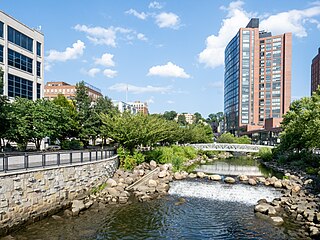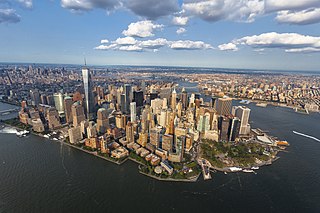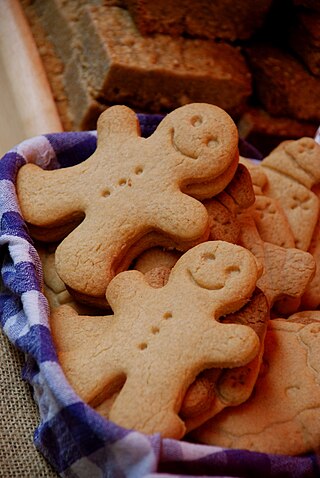Related Research Articles

Manhattan is the most densely populated and geographically smallest of the five boroughs of New York City. The borough is coextensive with New York County of the U.S. state of New York, one of the smallest counties by land area in the contiguous United States. Located almost entirely on Manhattan Island near the southern tip of the state, Manhattan constitutes the geographical and demographic center of the Northeast megalopolis and the urban core of the New York metropolitan area. Manhattan serves as New York City's economic and administrative center and has been described as the cultural, financial, media, and entertainment capital of the world.

Queens is a borough of New York City, coextensive with Queens County, in the U.S. state of New York. Located on Long Island, it is the largest of the five New York City boroughs by area. It is bordered by the borough of Brooklyn at the western tip of Long Island and by Nassau County to its east. Queens shares water borders with the boroughs of Manhattan, the Bronx, and Staten Island and with New Jersey.

Yonkers is a city in Westchester County, New York, United States. The city, a core suburb of the New York Metropolitan Area had a population of 211,569 as of the 2020 United States Census. It is classified as an inner suburb of New York City, located directly to the north of the Bronx and approximately 2.4 miles (4 km) north of Marble Hill, the northernmost point in Manhattan.

Candy Land is a simple racing board game created by Eleanor Abbott and published by Milton Bradley in 1948. The game requires no reading and minimal counting skills, making it suitable for young children. No strategy is involved as players are never required to make choices; only following directions is required. About one million copies per year are sold.

The New York metropolitan area, broadly referred to as the Tri-State area and often also called Greater New York, is the largest metropolitan area in the world by urban landmass, encompassing 4,669.0 sq mi (12,093 km2). The New York metropolitan area is one of the most populous metropolitan areas in the world and the only U.S. metropolitan area larger than twenty million residents as of the 2020 United States census. The vast metropolitan area includes New York City, the nation's most populous city, Long Island, the Mid- and Lower Hudson Valley in New York State; fourteen counties and eleven of the largest cities in New Jersey; and six of the seven largest cities in Connecticut. The phrase "Tri-State area" usually refers to New York / New Jersey / Connecticut, although an increasing number of people who work in New York City commute from Pennsylvania, particularly from the Lehigh Valley, Bucks County, and Poconos regions in eastern Pennsylvania. The New York metropolitan area is the geographic and demographic hub of the larger Northeast megalopolis.

A biscuit, in most English speaking countries, is a flour-based baked and shaped food product. Biscuits are typically hard, flat, and unleavened. They are usually sweet and may be made with sugar, chocolate, icing, jam, ginger, or cinnamon. They can also be savoury, similar to crackers. Types of biscuit include sandwich biscuits, digestive biscuits, ginger biscuits, shortbread biscuits, chocolate chip cookies, chocolate-coated marshmallow treats, Anzac biscuits, biscotti, and speculaas.

New York, often called New York City or simply NYC, is the most populous city in the United States, located at the southern tip of New York State on one of the world's largest natural harbors. The city comprises five boroughs, each of which is coextensive with a respective county. It is a global city and a cultural, financial, high-tech, entertainment, and media center with a significant influence on commerce, health care, scientific output, life sciences, research, technology, education, politics, tourism, dining, art, fashion, and sports. Home to the headquarters of the United Nations, New York is an important center for international diplomacy, and is sometimes described as the world's most important city and the capital of the world.

Gingerbread refers to a broad category of baked goods, typically flavored with ginger, cloves, nutmeg, and cinnamon and sweetened with honey, sugar, or molasses. Gingerbread foods vary, ranging from a moist loaf cake to forms nearly as crisp as a ginger snap.

A gingerbread man is a biscuit or cookie made from gingerbread, usually in the shape of a stylized human being, although other shapes, especially seasonal themes and characters are common too.

A gingerbread house is a novelty confectionery shaped like a building that is made of cookie dough, cut and baked into appropriate components like walls and roofing. The usual base material is crisp gingerbread, hence the name. Another type of model-making with gingerbread uses a boiled dough that can be moulded like clay to form edible statuettes or other decorations. These houses, covered with a variety of candies and icing, are popular Christmas decorations.

The New York Hall of Science, also known as NYSCI, is a science museum located in Flushing Meadows-Corona Park in the New York City borough of Queens, in the section of the park that is in Corona. It occupies one of the few remaining structures from the 1964 New York World's Fair, and is New York City's only hands-on science and technology center. The more than 400 hands-on exhibits focus on biology, chemistry, and physics.

The Galleria at Pittsburgh Mills, or simply Pittsburgh Mills, is a super-regional shopping center northeast of Pittsburgh, Pennsylvania in Frazer Township, along PA Route 28 near its intersection with the Pennsylvania Turnpike. The mall is the second largest shopping complex in Western Pennsylvania, and the main retail center for the Allegheny Valley with 905,667 sq ft (84,139 m2) of retail space on 200 acres (0.8 km2). The grand opening of the mall portion of Pittsburgh Mills was on July 14, 2005.

New York City is a large and ethnically diverse metropolis. It is the largest city in the United States with a long history of international immigration. The New York region continues to be by far the leading metropolitan gateway for legal immigrants admitted into the United States. The city is the geographical and demographic center of both the Northeast megalopolis and the New York metropolitan area, the largest metropolitan area in the U.S. by both population and urban area. With over 20.1 million people in its metropolitan statistical area and 23.5 million in its combined statistical area as of 2020, New York City is one of the world's most populous megacities.

The Grand Concourse is a 5.2-mile-long (8.4 km) thoroughfare in the borough of the Bronx in New York City. Grand Concourse runs through several neighborhoods, including Bedford Park, Concourse, Highbridge, Fordham, Mott Haven, Norwood and Tremont. For most of its length, the Concourse is 180 feet (55 m) wide, though portions of the Concourse are narrower.

An ontbijtkoek, peperkoek or kruidkoek is a Dutch and Flemish spiced cake. Rye and dark brown basterdsuiker are its most important ingredient, coloring the cake light brown. It is often spiced with cloves, cinnamon, ginger, succade and nutmeg. Several parts of the Netherlands have their own local recipe, of which the most famous is oudewijvenkoek, which is mostly eaten in the northern regions, and is flavored with aniseed. Ontbijtkoek is traditionally served at breakfast with a thick layer of butter on top, as a replacement for bread, however, due to its sweet taste it is also served as a snack. It is best eaten the day after it is baked, but has a shelve life of several weeks at room temperatures, without it spoiling, due to the pH, sugar content and used spices.

Education in New York City is provided by a vast number of public and private institutions. New York City has the largest educational system of any city in the world. The city’s educational infrastructure spans primary education, secondary education, higher education, and research. New York City is home to some of the most important libraries, universities, and research centers in the world. In 2006, New York had the most post-graduate life sciences degrees awarded annually in the United States, 40,000 licensed physicians, and 127 Nobel laureates with roots in local institutions. The city receives the second-highest amount of annual funding from the National Institutes of Health among all U.S. cities. It also struggles with disparity in its public school system, with some of the best-performing public schools in the United States as well as some of the worst-performing. Under Mayor Michael Bloomberg, the city embarked on a major school reform effort.

The Boroughs of New York City are the five major governmental districts that compose New York City. The boroughs are the Bronx, Brooklyn, Manhattan, Queens, and Staten Island. Each borough is coextensive with a respective county of the State of New York: The Bronx is Bronx County, Brooklyn is Kings County, Manhattan is New York County, Queens is Queens County, and Staten Island is Richmond County.

A Cornish fairing is a type of traditional ginger biscuit commonly found in Cornwall, England, United Kingdom. "Fairing" was originally a term for an edible treat sold at fairs around the country, though over time the name has become associated with ginger biscuits or gingerbread, which were given as a treat to children or by men to their sweethearts. In Cornwall, fairings contained ginger and became famous around the country when a Cornish manufacturer started selling them by mail order in 1886. The same manufacturer still makes them and the company has recently teamed up with celebrity chef Rick Stein to make biscuits.

The New York City FC stadium is a proposed soccer-specific stadium to be built in Willets Point in the New York City borough of Queens for New York City FC of Major League Soccer, who currently play home games at Yankee Stadium and Citi Field. The stadium is scheduled to be completed in 2027.
This article is a timeline of the history of New York City in the U.S. state of New York.
References
- 1 2 "Gingerbread Lane In Good Taste At Station Square". CBS Pittsburgh. Retrieved October 17, 2013.
- ↑ Lisa L. Colanego (November 18, 2013). "Chef crafts a 1.5 ton village of gingerbread, frosting and candy at the N.Y. Hall of Science". Daily News . Retrieved November 21, 2013.
- ↑ "GingerBread Lane" . Retrieved October 17, 2013.
- ↑ Megan Guza (August 3, 2012). "For gingerbread man, it's Christmas in August". TribLIVE News. Retrieved October 17, 2013.
- ↑ Madeline Stone (December 3, 2013). "A Chef Built The World's Largest Gingerbread Village In His Bronx Apartment". Business Insider. Retrieved March 23, 2014.
- ↑ "New York Hall of Science to Unveil GingerBread Lane on Sunday". Brownstoner Queens. November 12, 2013. Retrieved November 21, 2013.
- 1 2 "Queens Gingerbread Village Is World's Largest". The Wall Street Journal . December 13, 2013. Retrieved February 24, 2014.
- ↑ Anita Hamilton (December 2, 2013). "Baker of World's Largest Edible Gingerbread Village Doesn't Really Want You to Eat It". Time . Retrieved February 24, 2014.
- ↑ "Koch baut größtes Lebkuchendorf der Welt". Die Welt. December 9, 2013. Retrieved March 23, 2014.
- ↑ Denise Barnes (February 15, 2000). "Thinking outside the box D.C. Chef's creations no bite-size bonbons". The Washington Times .
- 1 2 Corey Kilgannon (November 26, 2013). "From a Bronx Apartment's Oven, a Gingerbread Colossus Rises in Queens". The New York Times . Retrieved February 24, 2014.
- ↑ AmyJo Brown (December 12, 2012). "Sweet City: Gingerbread Lane is product of chef's year-long passion". Pittsburgh City Paper. Retrieved October 17, 2013.
- ↑ Jill King Greenwood (January 15, 2011). "Missouri last stop for Pittsburgh gingerbread train station". TribLIVE News. Retrieved October 17, 2013.
- ↑ Lisa L. Colangelo (January 13, 2014). "Sharing the spoils of Gingerbread Lane". Daily News. Retrieved February 24, 2014.